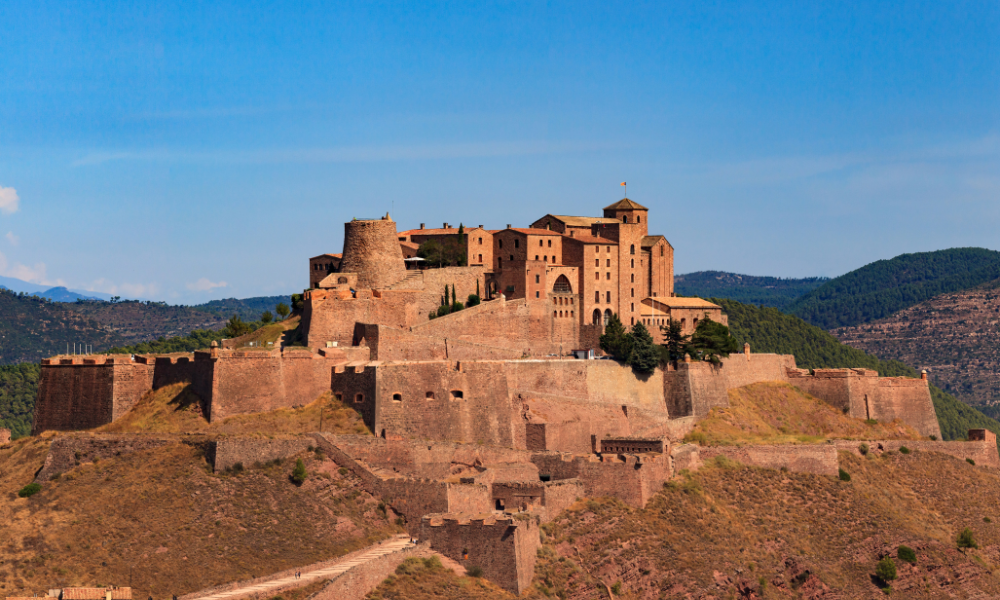- Rupit and Pruit: A trip to the medieval past
Rupit i Pruit is one of the most emblematic and picturesque towns in the province of Barcelona. Located in the Osona region, this medieval town seems to have come straight out of a fairy tale. Its cobbled streets, stone houses and slate roofs create a unique atmosphere, surrounded by a green and mountainous landscape. The wooden suspension bridge is one of its icons, offering a spectacular entrance to the center of the village. In addition, you cannot miss the Sant Miquel church, with its Romanesque bell tower and the incredible views from the Salt de Sallent viewpoint, an impressive waterfall over 100 meters high. For those who love hiking, Rupit i Pruit is also the starting point for several routes that allow you to discover the natural environment of the area, such as the path that leads to Tavertet, another charming town.

- Mura: Tradition and nature in harmony
Hidden in the Natural Park of Sant Llorenç del Munt i l’Obac, the town of Mura is an architectural and natural jewel. With its stone houses and narrow and winding streets, Mura is an ideal place to get lost and enjoy the tranquility. The Romanesque church of Sant Martí, built in the 11th century, is one of its main attractions and offers testimony to the town’s rich history. The natural park that surrounds it provides a wide variety of hiking routes that allow you to discover the native flora and fauna, as well as spectacular rock formations. The route to Font de l’Era, a small oasis with a waterfall and picnic area, is particularly popular with visitors. In Mura, tradition lives on in every corner, from its popular festivals to the local gastronomy, based on local and seasonal products.

- Sant Sadurní d’Anoia: Capital of Cava
Known as the capital of cava, Sant Sadurní d’Anoia is an essential town for lovers of wine and gastronomy. Located in the Alt Penedès region, this municipality is famous for its cavas, many of which can be visited to learn first-hand the process of making this emblematic drink of the region. Strolling through the historic center of Sant Sadurní is a unique experience. The modernist facades of the houses of the former cava producers reflect the splendor of the golden age of the wine industry. In addition, the Cava Interpretation Center offers total immersion in the history and culture of this product, with interactive exhibitions and cava tastings. If you visit Sant Sadurní at the beginning of October, you cannot miss the Festa de la Phylloxera, a traditional celebration that recreates the farmers’ fight against this pest that affected the vineyards at the end of the 19th century.

- Talamanca: Between history and landscape
Talamanca is a small town, but full of character and history, located in the Natural Park of Sant Llorenç del Munt i l’Obac. With less than 200 inhabitants, it is a perfect place for those looking for peace and quiet. The remains of Talamanca Castle, built in the 10th century, dominate the town and offer impressive panoramic views of the surroundings. Strolling through its streets is like traveling back in time, thanks to the stone houses and traditional constructions that have been preserved almost intact over the centuries. In addition, the town is an excellent starting point for exploring the landscapes of the natural park, with routes that lead to emblematic places such as La Mola or Montcau. During the spring, the fields of flowers that surround Talamanca make the landscape even more spectacular.

- Cardona: The town of castles and salt
Cardona is mainly known for its imposing castle, a medieval fortress that has witnessed numerous historical episodes and is now a national landmark. Located in the Bages region, this town combines history, architecture and nature in a masterful way. The castle, with its tower of the maid and the Romanesque church of Sant Vicenç, is a must-see for any history enthusiast. But Cardona is not only notable for its castle. The Salt Mountain, an impressive geological phenomenon that has been exploited for centuries, offers a unique visit to its underground galleries. These salt mines are a reminder of the importance this mineral had for the town and its economy. Walking through the historic center of Cardona, with its cobbled streets and squares, is like going back to medieval times, and its shops and restaurants offer typical products and specialties of the local cuisine.



